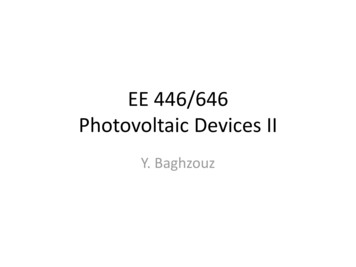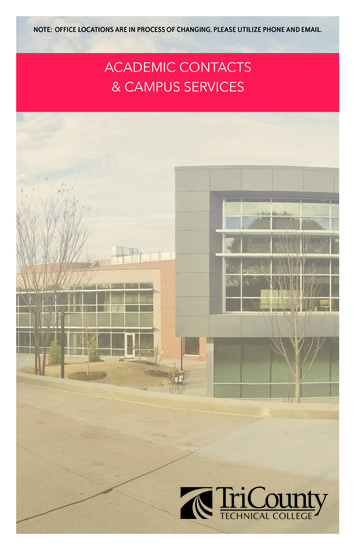EE 446/646 Photovoltaic Devices II - UNLV
EE 446/646Photovoltaic Devices IIY. Baghzouz
The p-n junction diode Before discussing the case when a p-n junction isexposed to sunlight, it is worth reviewing the p-njunction diode since it has some commonelectrical characteristics. A diode is an electronic component that consistsof a p-n junction, just like a solar cell, except thatit has a much smaller surface and thesemiconductor material is not exposed as bothsides are entirely covered with electrical contactmaterial. With no external voltage, a diode is basically a p-njunction that is under equilibrium betweendiffusion and drift currents, as described earlier.
Diode Under Forward Bias When a voltage is applied across theterminals of a diode with the positiveside connected to the p-type materialand the negative side connected to then-type material, the diode is said to bein the forward bias state.In forward bias, the applied electric fieldby the voltage source is in oppositedirection of that of the built-in electricfield in the depletion region.The net electric field is weakened, thusreducing the barrier to the diffusion ofcarriers from one side of the junction tothe other. This results in an increase inthe diffusion current.
Diode Under Forward Bias The majority carriers are supplied fromthe external circuit, hence resulting in anet current flows under forward bias. In a semiconductor, the minoritycarriers recombine and thus morecarriers can diffuse across the junction. Consequently, the diffusion currentwhich flows in forward bias is arecombination current. The higher therate of recombination events, thegreater the current flow.
Diode Under Reverse Bias In reverse bias, a voltage isapplied across the device is suchthat the electric field at thejunction increases. The higher electric field in thedepletion region decreases theprobability that carriers can diffusefrom one side of the junction tothe other, hence the diffusioncurrent decreases. As in forward bias, the drift currentis limited by the number ofminority carriers on either side ofthe p-n junction, and is relativelyunchanged by the increasedelectric field.
p-n junction diode - recap– When a forward voltage Vd is applied across the diodeterminals, current would flow easily through the diodefrom the p-side to the n-side. The forward voltage acrossthe diode is only a few tenths of a volt.– If we try to send current in the reverse direction, only avery small (nA - pA ) reverse saturation current I0 willflow (result of thermally generated carriers with theholes being swept into the p-side and the electrons intothe n-side). I0 is often referred to as the “dark saturationcurrent”.
Diode voltage-current characteristic The voltage– current characteristic curve for the p –n junctiondiode is described by the following Shockley diode equation: where q is the electron charge (1.602 10 19 C), k isBoltzmann’s constant (1.381 10 23 J/K), and T is the junctiontemperature (K), and Io is the dark saturation current.@ 25oC
Ideality Factor In general, where A is the ideality factor.– A 1 if the transport process is purely diffusion,– A 2 if the transport process is primarily recombination in thedepletion region.
p-n junction cell exposed to sunlight When placed in the dark, a photovoltaic cell behaves like a p-njunction diode. When it is exposed to sunlight.– Photons with sufficient energy are absorbed by the semiconductorand form hole-electron pairs.– If these mobile charge carriers reach the vicinity of the junctionbefore they recombine, the electric field in the depletion region willpush the holes into the p-side and push the electrons into the n-side.Hence, the p-side accumulates more holes and the n-sideaccumulates more electrons.
p-n junction cell exposed to sunlight This separation of charge creates an electric field at the junctionwhich is in opposition to that already existing at the junction, hencea weaker net electric field which increases the diffusion current. If the light-generated carriers are prevented from leaving the solarcell, the forward bias of the junction increases to a point where thelight-generated current is exactly balanced by the forward biasdiffusion current, and the net current is zero. The resulting voltageat the cell terminals under this condition is called the open-circuitvoltage.
p-n junction cell exposed to sunlight when the cell terminals are connected to an external circuit, the lightgenerated electrons are provided an external path, while the holes remainstuck in the p-type semiconductor since they cannot flow through wire.Herein, the electrons will flow out of the n-side through the connecting wire tothe load, and then recombine with holes that are waiting on the p-side.In this case, the forward bias of the junction decreases to a point where thelight-generated current is equal to the current supplied to the load (which isequal to electron drift minus electron diffusion). The result is a decrease indiffusion current due to an increase in the net electric field across the junction.
Generic PV cell When a p –n junction is exposed to sunlight,– As photons are absorbed, hole-electron pairs may be formed.– If these mobile charge carriers reach the vicinity of thejunction, the electric field in the depletion region will push theholes into the p-side and push the electrons into the n-side.– The p-side accumulates holes and the n-side accumulateselectrons, This creates a stronger electric field, and hencestronger voltage.
External current flow– If electrical contacts are attached to the top and bottom of thecell, electrons will flow out of the n-side into the connectingwire, through the load and back to the p-side (a wire cannotconduct holes).– When they reach the p-side, they recombine with holescompleting the circuit.– By convention, positive current flows in the direction oppositeto electron flow.
Simple Equivalent Circuit A simple equivalent circuit model for a photovoltaic cell consistsof a real diode in parallel with an ideal current source. The ideal current source delivers current in proportion to thesolar flux to which it is exposed.
Short-circuit current and open-circuit voltage The short-circuit current ISC is defined as the current that flowswhen the terminals are shorted together. This is equal to themagnitude of the ideal current source. The open-circuit voltage VOC is defined as the voltage acrossthe terminals when the leads are left open.
Current-voltage relation Relation between the short-circuit, diode, and load currents: Substituting the diode current equation: At 25oC,
I-V Curve The open-circuit voltage can be found by setting the loadcurrent to zero: At 25oC,
Example Consider a 100-cm2 photovoltaic cell with reverse saturationcurrent Io 10 12 A/cm2 . In full sun, it produces a short-circuitcurrent of 40 mA/cm2 at 25o C. Find the open-circuit voltageat full sun and again for 50% sunlight. Plot the results.
A more accurate equivalent circuit Addition of parallel leakage resistance RP to account formanufacturing defects The ideal current source ISC in this case delivers current to thediode, the parallel resistance, and the load: For a cell to have losses of less than 1% due to its parallelresistance, RP should be greater than 100VOC/ISC.
A more accurate equivalent circuit Addition of series resistance RS to account for the resistance tothe movement of current through the p-n materials; thecontact resistance between metal and silicon; the resistance ofthe top and rear metal contacts. The diode voltage and load voltage are related by For a cell to have losses of less than 1% due to its seriesresistance, RS should be greater than 0.01VOC/ISC.
Final accurate equivalent circuit Addition of both series resistance RS and parallel resistance RP. The current –voltage equation becomes (non explicit) At 25oC,
Useful current-voltage relationships Short circuit current in terms of load current, diode current,and parallel resistor current Load current in terms of diode current, short-circuit currentand diode voltage Relation between load voltage and diode voltage
ProblemsE hv hc/λP VIPout VIη Pout/Pin
Problems P VIη Pout/Pin Rp V/ΔI 0.4/0.2 2Ω
Problems Rs ΔV/I 0.04/1 0.04 Ω P VIConsider the cell equivalent circuit below. The followingParameters are known: Isc, Io, Cell temp, Rp, Rs and Vd.1) Compute the power supplied by the cell.
Photovoltaic Devices II Y. Baghzouz . The p-n junction diode Before discussing the case when a p-n junction is exposed to sunlight, it is worth reviewing the p-n junction diode since it has some common electrical characteristics. A diode is an electronic component that consists
Sparrow W G 646-2337 Spyrol Agencies 646-2760 Stadnick Donald L 646-2247 Stafford George 646-2289 Stafford John 646-2290 Stark L 646-2564 Stecyk Wm Ascot Beach 646-2405 Stecyk William S 646-2279 Stephenson Albert ' 646-2445 Stephenson Calvin 646-2468 Steves H 646-2440 Stogryn William 646-2238
Assistant Director, Readiness, Response & Recovery Directorate (202) 646-3692 (202) 646-4060 Katchka, Elizabeth H. (Lisa) Acting Associate General Counsel, Program Law Division (202) 646-4093 (202) 646-4536 Kernan, Edward W. Director, Management Division, ITS Directorate (202) 646-2986 (202) 646-3074 Lawless, Margaret
photovoltaic power generation system will be established in order to carry out the next step-by-step process simulation study. 2.1. Photovoltaic array mathematical model and Simulink model 2.1.1. Mathematical model of photovoltaic array Based on the theory of electronics, photovoltaic panels are affected by light to produce
The problem of integrating photovoltaic modules into the built environment is different now from a few years ago when photovoltaic systems were only imagined in isolated sites. Photovoltaic comes to the city, by the technique of connection to the power utility grid. Our goal in this study was the simulation of a photovoltaic system and its
446 West 14th Street of Project Issue Date W 14th ST. N WASHINGTON ST. LPC Filing 09/19/18 T 212 989 2853 New York, NY 10010 18 West 21st Street, 3rd Floor Rodney D. Gibble Consulting Engineers Landscape Architect T 212 868 9411 New York, NY 10013 107 Grand Street, 6th Floor T000.00 COVER SHEET 446 WEST 14th STREET Rooftop Terrace 446 West 14th .
Mandy Elmore amandal.elmore@tctc.edu, 646.1404, CD 131A OFFICE MANAGER Tonia McClain tmcclain@tctc.edu, 646.1422, CD 131 ACADEMIC RESOURCE SPECIALIST Brittany Talbert btalbert@tctc.edu, 646.1517, CD 152 WORKFORCE SOLUTIONS COORDINATOR Ken Fletcher kfletch2@tctc.edu, 646.1518, CD 114 ENGINEERING ADVISOR Ross Wagenseil
Macropoxy 646 is an architectural coating manufactured by The Sherwin-Williams Company, headquartered in Cleveland, Ohio. Macropoxy 646 is manufactured in a number of Sherwin-Williams facilities across the globe and the data used by the LCA were representative of all Sherwin-Williams facilities in which Macropoxy 646 was produced.
Health and safety guidelines for home care workers 3 local authority voluntary/community sector or private agency settings. Health and safety is covered in standards 11-15, and lists all the relevant health and safety legislation. The regulations specify that each agency has to have a comprehensive health and safety policy and written procedures for health and safety management. These should .























